Advances in Algae-Mediated Bioremediation of Phenolic Pollutants Progress and Emerging Issues
*Corresponding Author: Romero Guilty, Department of Civil and Environmental Engineering, Colorado School of Mines, USA, Email: romeroty56@gmail.comReceived Date: Jan 01, 2025 / Published Date: Jan 30, 2025
Citation: Romero G (2025) Advances in Algae-Mediated Bioremediation ofPhenolic Pollutants Progress and Emerging Issues. J Bioremediat Biodegrad, 16:667.
Copyright: © 2025 Romero G. This is an open-access article distributed underthe terms of the Creative Commons Attribution License, which permits unrestricteduse, distribution, and reproduction in any medium, provided the original author andsource are credited.
Abstract
Phenolic pollutants, commonly found in industrial effluents, pose serious environmental and health risks due to their toxicity and persistence in ecosystems. Algae-mediated bioremediation has gained significant attention as a sustainable and cost-effective approach for the removal of phenolic compounds from contaminated environments. This review provides an overview of the recent advancements in algae-based bioremediation strategies, focusing on the mechanisms of phenolic pollutant degradation, the role of different algal species, and the optimization of environmental conditions for enhanced remediation efficiency. The paper highlights the use of both microalgae and macroalgae in the biodegradation process, including the identification of key metabolic pathways involved. Furthermore, it addresses emerging challenges such as the scalability of algae-based systems, the potential for bioaccumulation of pollutants, and the need for further research into genetic and metabolic engineering to improve algal remediation capabilities. The review concludes by discussing future directions for the development of algae-mediated bioremediation technologies to mitigate phenolic pollution and promote sustainable environmental practices.

 Spanish
Spanish  Chinese
Chinese  Russian
Russian  German
German  French
French  Japanese
Japanese  Portuguese
Portuguese  Hindi
Hindi 
